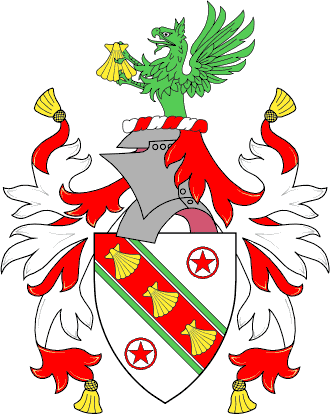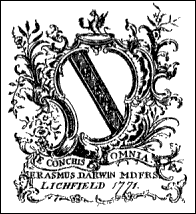The above central picture was composed by John Gaylor
who did not include the mullets and annulets at first
(thus depicting the undifferenced arms of Erasmus Darwin).
Gaylor explained:
"The arms illustrated were given in Burke's General Armory
as those of Charles Robert Darwin, of Down House, Kent.
This was the naturalist himself,
and it seems clear that he did not bear any difference marks in his arms,
that is, he bore the same arms as his grandfather Erasmus."
Well, according to
François Velde, the version with the mullets and annulets is listed by
A. Wagner; Fox-Davies, Armorial Families.
This was the source of the blazon and (small) escutcheon we had been showing
here for years,
before receiving John Gaylor's artwork (on 2006-05-24) in reply to a
query of
Jochen Wilke on the Scots Heraldry Forum.
The cadency system
which was designed and enforced at the time of the Tudors
used mullets (3rd son) and annulets (5th son) as difference marks for junior houses.
However, this could only have been a loose source of inspiration for
the difference marks featured here:
Charles Darwin was the second son of Robert Waring Darwin,
a successful physician
whose money made it unnecessary for Charles to seek employment.
In 1842, Charles Darwin married his first cousin (Emma Wedgwood) by whom he had 10 children,
three of whom (George, Francis,
and Horace) became distinguished scientists themselves.
Charles Darwin's older brother (Erasmus) never married.
It's thus quite possible that Charles inherited (and/or passed on)
the undifferenced arms of his famous grandfather...
Pending further investigation to resolve contradictory information from equally authoritative
sources, we're still showing different arms for
Erasmus Darwin and his grandson Charles... Stay tuned and/or
tell us
what you know. Thanks.



Evolution of Species by Natural Selection :
What's popularly known as the "theory of evolution"
did not originate at all with Charles Darwin.
The basic principle was already laid out by the ancient Greeks and
it was advocated, among many others, by Lamarck (1744-1829) and by
Charles Darwin's own grandfather,
Erasmus Darwin,
MD, FRS (1731-1802)
who was an eminent scientist himself.
Decades before the birth of Charles Darwin, the coat-of-arms of Erasmus Darwin
(bookplate at left) was already sporting the
militant motto
E Conchis Omnia (everything from shells).
Erasmus was accused of "renouncing his creator" by his neighbor,
Thomas Seward (1708-1790) canon of Lichfield Cathedral and father of the poet
Anna Seward
("the Swan of Lichfield", 1747-1809).
Reverend Seward "exhorted" Erasmus Darwin to renounce his "foolish motto"
or risk the defection of a number of his patients...
Darwin had to paint over the motto on his carriage.
What Charles Darwin discovered is actually an explanation
for the evolution of living species, namely
natural selection
(survival of the fittest).
For some obscure reason, this simple scientific explanation has been the focus of
more than its share of religious outcry
(at least in some parts of the World, including the US).
Some religious groups still find the very idea of biological evolution
blasphemous,
especially concerning the human species itself.
Unfortunately, in such religious controversies,
Charles Darwin merely plays the rôle of the heretic
and his actual ideas are rarely discussed, if ever.
In this context, some words have even acquired twisted meanings which prevent
further dialog. For example, the very word
"theory" becomes a self-contained insult ("It's just a theory!")
instead of the normal designation for a self-consistent body of knowledge
(as in "Theory of Relativity").
It's often all too clear that
"scientific proofs" can be demanded by people with a very fuzzy grasp of either
concept (the scientific method on one hand and
mathematical proofs
on the other).
Outside of mathematics, a scientific theory can only be disproved, never proved;
this is precisely what makes it scientific.
We argue that Science and Religion have (or should have)
disjoint domains.
One cannot contradict the other, or even be opposed to it, believe me
(pun intended).
Organs of extreme perfection and complication.
To suppose that the eye with all its inimitable contrivances for adjusting the focus to
different distances, for admitting different amounts of light, and for the correction of
spherical and chromatic aberration, could have been formed by natural selection, seems,
I freely confess, absurd in the highest degree.
Yet reason tells me, that if numerous gradations from a perfect and complex eye to one very imperfect and simple,
each grade being useful to its possessor, can be shown to exist; if further, the eye does vary ever so slightly,
and the variations be inherited, which is certainly the case;
and if any variation or modification in the organ be ever useful to an animal under changing conditions of life,
then [...] a perfect and complex eye could be formed by natural selection [...]
Charles Darwin (1809-1882) in
The
Origin of Species (1859)



